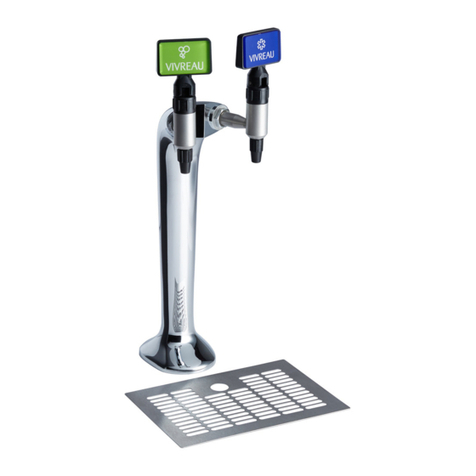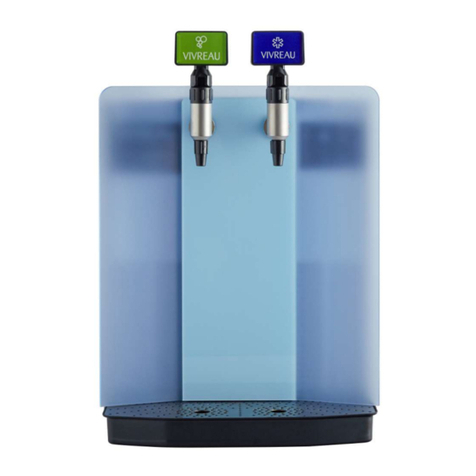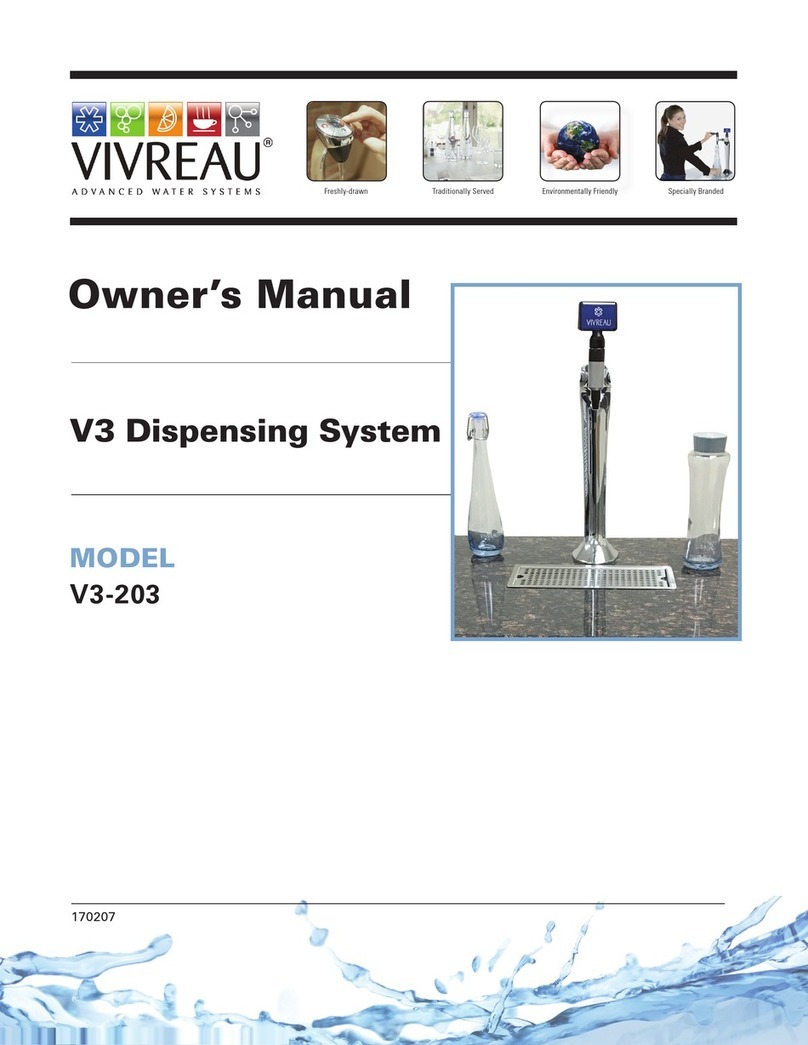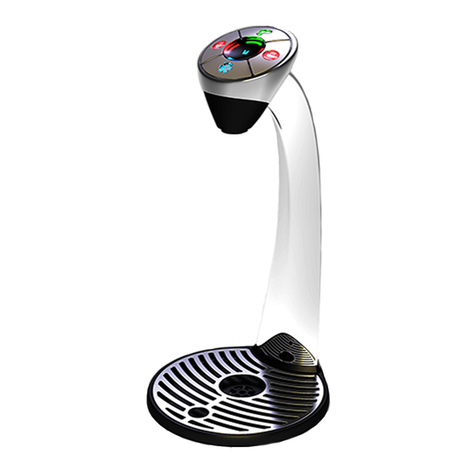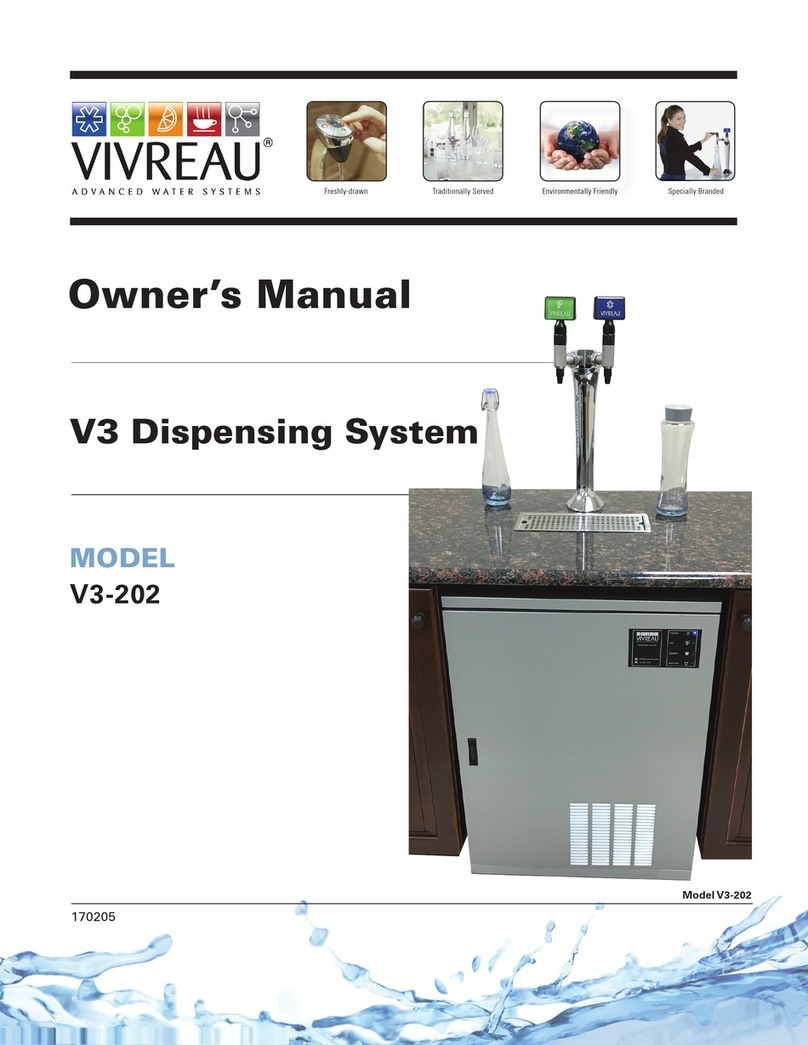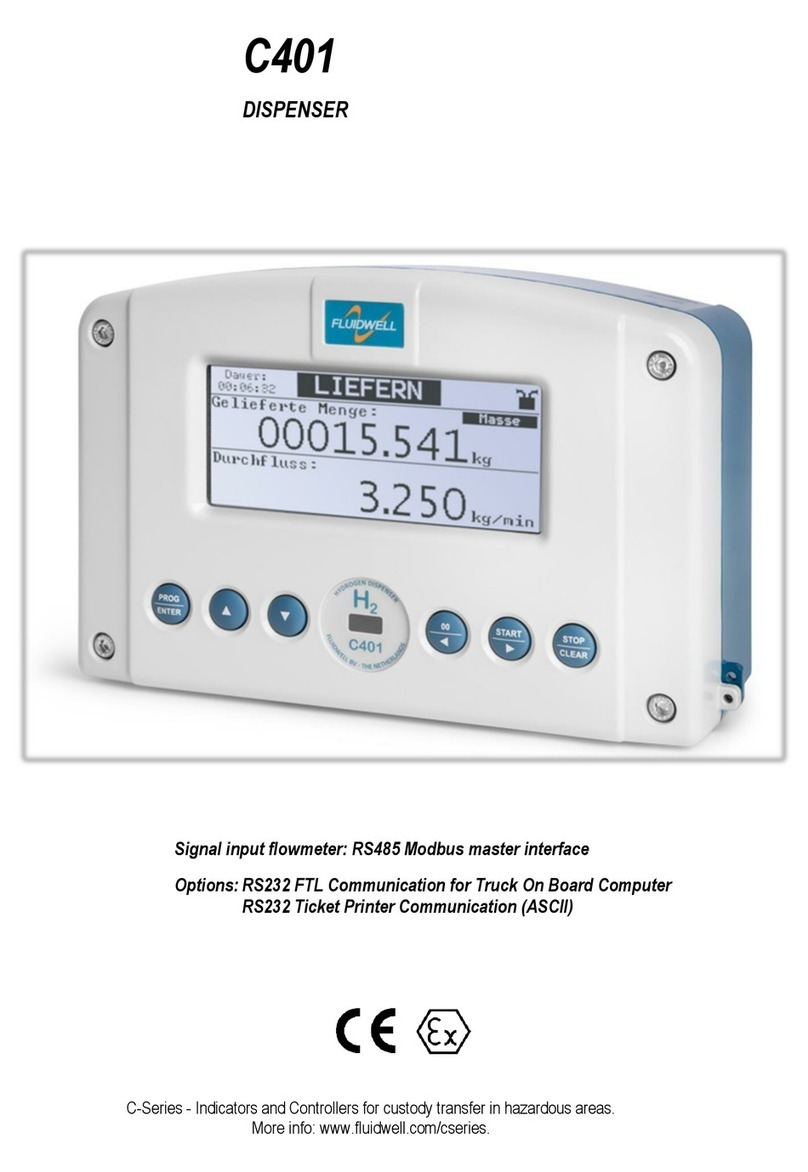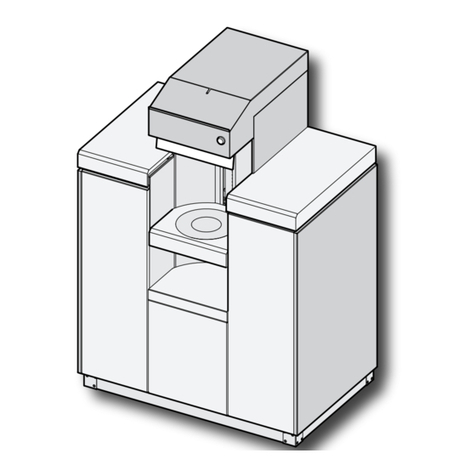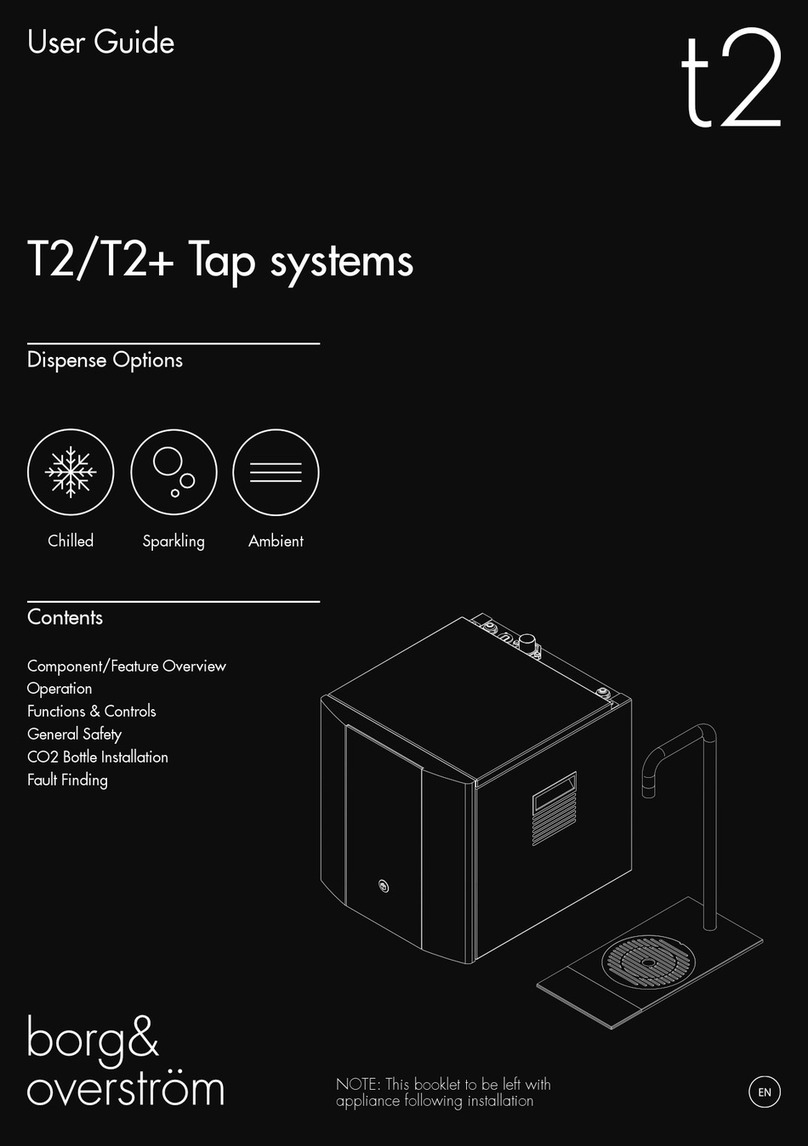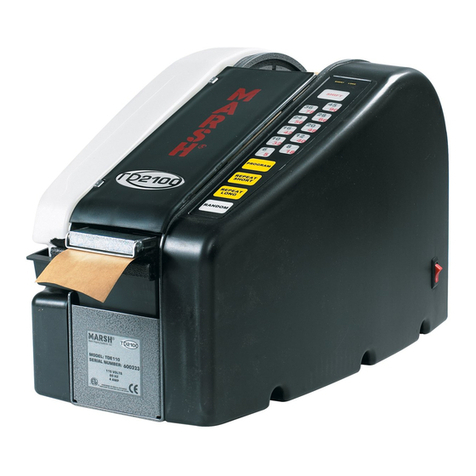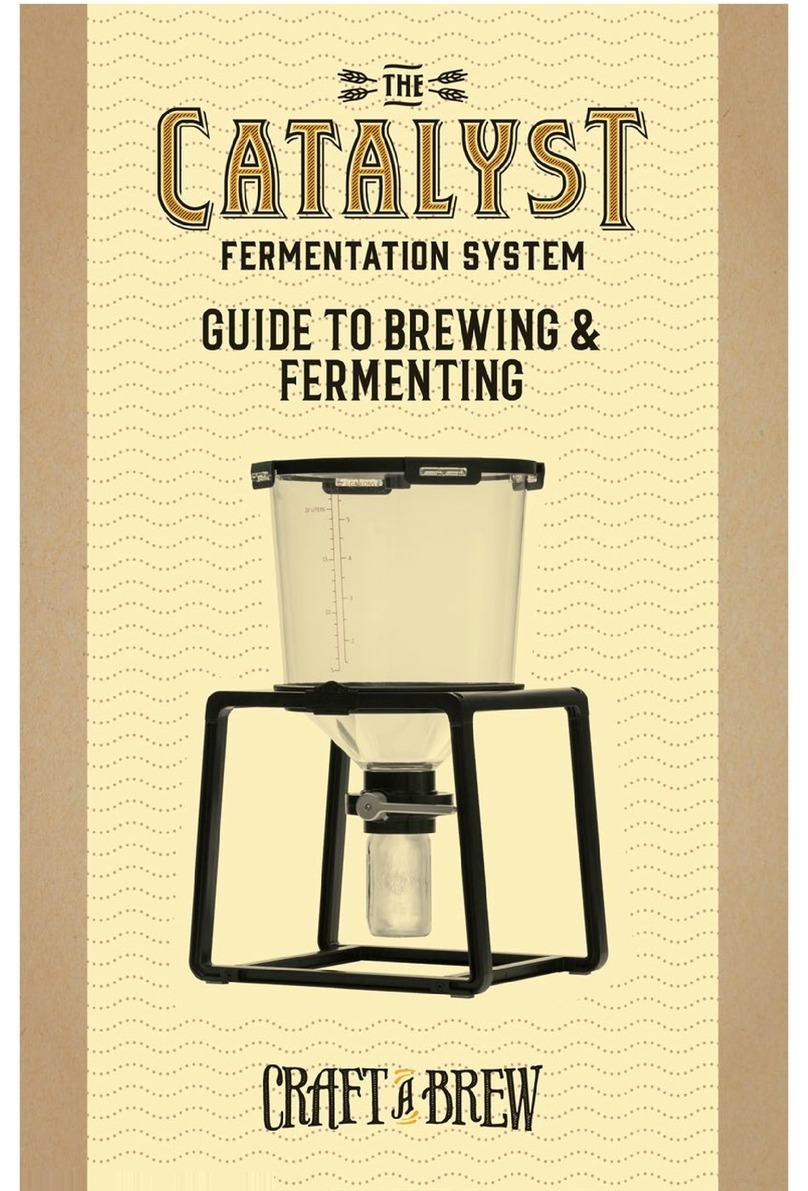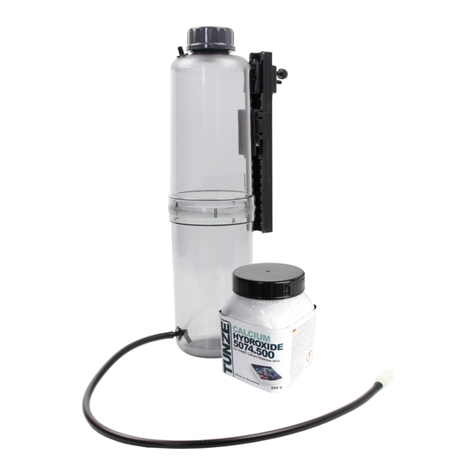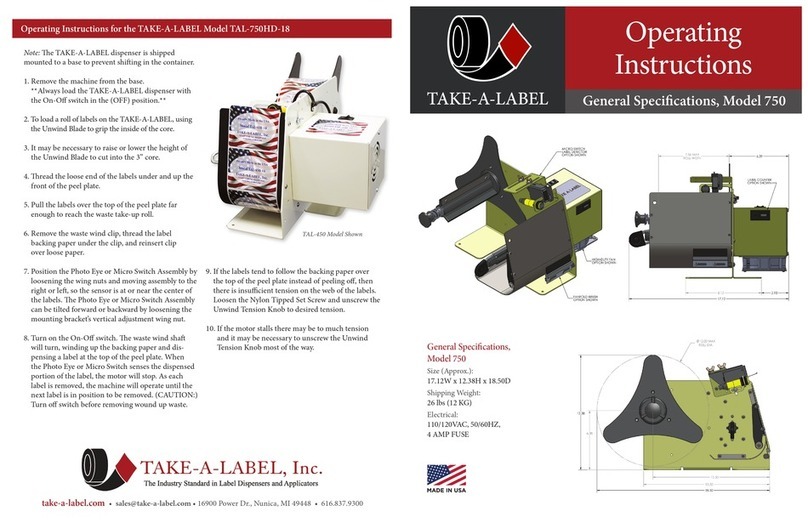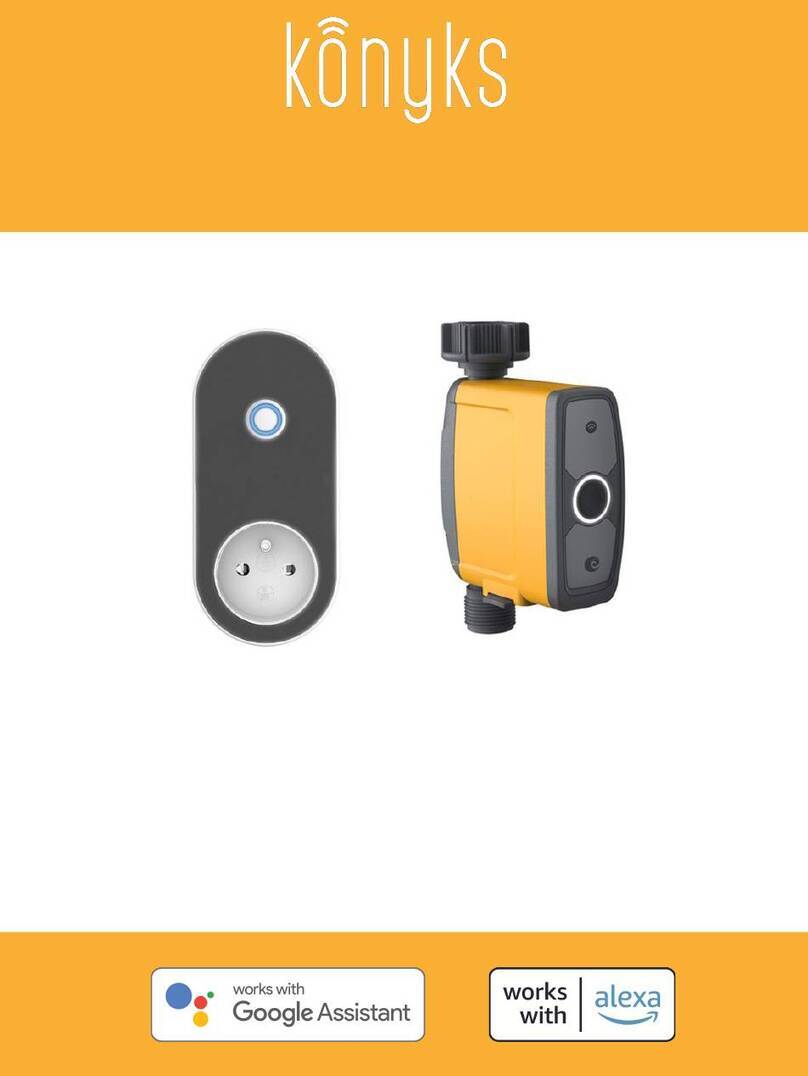Vivreau ViTap-2 User manual

1
Vi Tap Dispensing System
Service Manual

2 3
Table of contents
Safety Precautions .......... ...................................................................3
General Information..............................................................................4
Technical Specications......................................................................5
Installation.............................................................................................7
Operating Instructions........................................................................15
Maintenance.........................................................................................18
Troubleshooting...................................................................................26
Wiring Diagrams...................................................................................38
Illustrated Parts List.............................................................................40
© 2020 Vivreau Water Systems
All rights reserved.
Any and all information contained within this document is subject to
change without prior notice.
IMPORTANT ______________
The information contained in this manual is
specific to your system. It is IMPORTANT
you READ, FOLLOW and UNDERSTAND the
instructions given.
This manual and all material provided with your
system should be retained in a convenient location
for future reference.
Contact Vivreau if you have any questions
regarding the information contained in this
manual.
Safety precautions
IMPORTANT ________________________
This manual is intended for use only by
personnel trained in the operation of the
Vivreau ViTAP Dispensing System.
WARNING
Improper installation, adjustment,
alteration, service or maintenance can cause
property damage, injury, or death. Read the
installation, operating, and maintenance
instructions thoroughly before installing,
operating, or maintaining this equipment.
WARNING
Keep the area around the unit
clear of any combustible materials.
WARNING
Do not store or use gasoline
or other flammable vapors or liquids in the
vicinity of this or any other unit.
IMPORTANT ________________________
Carefully read, understand and follow all safety
instructions in this manual and safety labels
on the unit.
• Keep safety labels in good condition and
replace missing or damaged items.
• Learn how to operate the unit and how to use
the controls properly.
• Do not let anyone operate the unit without
proper training.
• In the event of a power failure, do not attempt to
operate this unit.
• Keep unit in proper working condition and do
not allow unauthorized modications to the unit.
WARNING
Only trained and certied electrical,
plumbing and refrigeration technicians should
service this unit.
WARNING
ALL WIRING AND PLUMBING
MUST CONFORM TO NATIONAL AND LOCAL
CODES. FAILURE TO COMPLY COULD RESULT
IN SERIOUS INJURY, DEATH OR EQUIPMENT
DAMAGE.
SAFETY PRECAUTIONS ________________
This unit has been specifically designed to
provide protection against personal injury.
To ensure continued protection observe
the following:
WARNING
Disconnect power to the unit
before servicing. Follow all LOCKOUT/TAGOUT
procedures. Verify power to the unit is OFF and
disconnected before any work is performed.
Failure to do so could result in serious injury,
death or equipment damage.
• To protect against electric shock, do not
immerse power cord in water or other liquid.
• To prevent damage to the power cord, do not
allow cord to hang over the edge of a table or
counter, or come in contact with hot surfaces.
• Isolate unit from power supply (unplug or turn
OFF breaker) and turn OFF the water supply
when not in use and before cleaning.
• Allow Boiler (if supplied) to cool before
removing any components.
• The use of spare parts and accessories not
recommended by Vivreau may cause damage
and/or injuries.
• Do not operate any unit with damaged cords,
plugs, or after the unit malfunctions or has
been damaged in any manner.
• Do not use outdoors.
• Do not place on or near a hot gas or electric
burner.
• Do not use the unit for anything other than its
intended use.
• Save these instructions.

4 5
INFORMATION FOR THE READER
To nd specic topics of interest quickly, refer
to the Table of Contents at the beginning of this
manual.
This manual is solely for the use of personnel
trained in the operation of the ViVreau Vi Tap
Dispensing System only.
PURPOSE OF THE MANUAL
• Vivreau has produced this manual to provide
necessary information to qualied and
authorized personnel for the safe and proper
installation, operation, and maintenance of the
Vivreau Vi tap 2, Vi Tap 2H, Vi Tap 1, and Vi Tap
1H Dispensing Systems.
• Information contained in this manual will help
prevent risks to health and safety, and the risk
of economic losses.
• Keep this manual in a clearly identied and safe
place throughout the working life of the unit, so
that it will always be available as needed.
• The manufacturer reserves the right to make
modications to the unit without any obligation
to provide prior notice.
• A number of symbols have been used to
highlight particularly important parts of the text
or important specications. Their meaning is as
dened below.
DANGER
INDICATES AN IMMINENTLY HAZARDOUS
SITUATION WHICH, IF NOT AVOIDED, WILL
RESULT IN DEATH OR SERIOUS INJURY.
WARNING
Indicates that suitable procedures must be
adopted to avoid putting people’s health and
safety at risk or causing economic losses.
CAUTION
Indicates a potentially hazardous situation
which, if not avoided, may result in property
damage, minor or moderate injury.
IMPORTANT ________________________
Indicates important technical information
which must not be overlooked.
Technical Specications
GENERAL DESCRIPTION
The Vi tap is a self-service water dispensing system
designed for under-counter installation with the
dispenser head mounted to the countertop directly
above the unit.
The system is made up of several components
(depending on model) that will t under a standard
base-cabinet section that is 30” wide (min.)
Dispensing Specications
Description Specication ViTap-2 ViTap-2H ViTap-1 ViTap-1H
Chilled still water ΔT=18 °F @ 15.8 gal/h ü ü ü ü
Chilled sparkling water ΔT=18 °F @ 15.8 gal/h ü ü NA NA
Hot water 203°F NA üNA ü
Hot water, immediate dispense 0.5 gal/h NA üNA ü
Hot water, storage capacity 1.2 gal. NA üNA ü
Water Pressure at Dispensing Head 5 PSI ü ü ü ü
Operating Conditions
Description Specication ViTap-2 ViTap-2H ViTap-1 ViTap-1H
Temperature 60 – 90°F ü ü ü ü
Relative Humidity 60% (max.) ü ü ü ü
Water Supply Requirements
Description Requirements ViTap-2 ViTap-2H ViTap-1 ViTap-1H
FNPT connection with Ball Valve 1/2” ü ü ü ü
PSI (min.) 50 ü ü ü ü
GPH (min.) 80 ü ü ü ü
Temperature (max.) 60°F ü ü ü ü
CO2Operating Pressure
Description Requirements ViTap-2 ViTap-2H ViTap-1 ViTap-1H
Pressure 65 – 70 PSI ü ü NA NA
Supply pressure (Bulk System) 100 PSI (min.) ü ü NA NA
Dispensing Head Specications
Description Requirements ViTap-2 ViTap-2H ViTap-1 ViTap-1H
Height 13” ü ü ü ü
Distance Nozzle to Drip Tray 9.6” ü ü ü ü
Weight 7.4 lb ü ü ü ü
General Information

6 7
Installation
PRE-INSTALLATION
Below are the services required to be in place prior
to the installation of the Vivreau ViTAP Dispensing
System. If you have any questions regarding these
or other services, please contact Vivreau Service
Toll-Free at 877-999-1044.
WATER SUPPLY
A potable 1/2” cold water supply terminating in a
1/2” Ball Valve, 1/2” female pipe thread.
IMPORTANT ________________________
Ball Valve must be accessible for service
and installation.
Minimum Water Pressure: 50 PSI
Minimum Water Flow: 80 gallons per hour
IMPORTANT ________________________
The Vivreau ViTAP Dispensing System
incorporates backow prevention. Any additional
backow devices required by State or Local
Code must also be supplied by the customer
prior to installation. There must not be any
other Filters/Pre-Filters inline before the unit.
ELECTRICAL OUTLET
Model ViTAP-2
(1) 20 Amp Electrical Recepticle (NEMA 5-20R)
120V, 60 Hz (11 Amps)
Model ViTAP-2H
(2) 20 Amp Electrical Recepticle (NEMA 5-20R)
120V, 60 Hz (11 & 13 Amps)
Model ViTAP-1
(1) 20 Amp Electrical Recepticle (NEMA 5-20R)
230V, 60 Hz (11 Amps)
Model ViTAP-1H
(2) 20 Amp Electrical Recepticle (NEMA 5-20R)
230V, 60 Hz (11 Amps)
All outlets must be mounted high in the cabinet to
avoid accidental contact with water.
CO2
CO2Cylinder (Customer supplied) - Size should be
selected based on available space.
NOTE: If connecting to a bulk or existing CO2
system, a CO2line terminating at a 1/4” Barbed
Shutoff Valve must be available within 40” of the
unit with 100 PSI minimum pressure.
DRIP TRAY AND DISPENSING HEAD
CUTOUTS
Cut out the holes for the Drip Tray and Dispensing
Head per the supplied template.
NOTE: The Dispensing Head must be mounted
on the work surface directly above the Chiller/
Carbonator.
DRIP TRAY DRAIN
Drip Tray must be plumbed to a drain. Customer
will need to supply a drain according to State and
Local Codes. Drain must be at least 1-1/4” ID.
VENTILATION
If the system is to be installed in an enclosed
space or in a cabinet, adequate ventilation must
be provided. Ventilation must be at the top and
bottom of the enclosure for proper air ow.
CAUTION
Failure to provide adequate
ventilation will cause system failure.
This unit is to be installed indoors only.
LOCATION OF SERVICES
All services must be accessible for installation and
service. Ensure all services are kept within 40” of
the Vivreau ViTAP Dispensing System.
Water Shutoff Valve to be located at low level.
Ensure there is sufcient room for a 6” long tting to
be connected to the Water Shutoff Valve.
Top of drain should be located between 12” and
18” from oor level.
SHIPPING DAMAGE/MISSING PARTS
Unpack and inspect the unit for shipping damage
and/or missing parts. If any damage or missing
parts are found, contact Vivreau Service Toll-
Free at 877-999-1044 and report the missing or
damaged parts.
Cooler/Carbonator Specications
Description Specication ViTap-2 ViTap-2H ViTap-1 ViTap-1H
Width 15” ü ü 8.25” 8.25”
Height 20” ü ü 19” 19”
Depth 18.5” ü ü 14" 14”
Weight 39.6 lb. ü ü 44.6 lb 44.6 lb
Voltage 110/120 VAC/60 Hz ü ü ü ü
Amperage 11A ü ü ü ü
Boiler Specications
Description Specication ViTap-2 ViTap-2H ViTap-1 ViTap-1H
Width 5.25” NA üNA 5.37”
Height 22” NA üNA 21”
Depth 15.75” NA üNA 15.62”
Weight 30.8 lb NA üNA 18.2 lb
Voltage 110/120 VAC/60 Hz NA üNA 120 V
230/240 VAC/60 Hz NA NA NA 240 V
Amperage
13A NA üNA ü
11A NA NA NA ü

8 9
INSTALLER’S CHECKLIST
Below are the services required to be in place prior
to the installation of the Vivreau ViTAP Dispensing
System. Please review and check all services
before beginning work. If anything is missing or not
correct, do not start the installation. Call Vivreau
Service for instructions at 877-999-1044.
WATER SUPPLY
A potable 1/2” cold water supply terminating in a
1/2” Ball Valve, 1/2” female pipe thread.
IMPORTANT ________________________
Ball Valve must be accessible for service and
installation.
Any water line or valve less than 1/2” is not
acceptable. Must be a direct supply with no
other Inline Filters.
ELECTRICAL OUTLET(S)
All Electrical Outlets must be within 40” of unit. No
Extension Cords.
Model ViTAP-2
Chiller/Carbonator
20 Amp Electrical Recepticle (NEMA 5-20R)
120V, 60 Hz (11 Amps)
Model ViTAP-2H
Chiller/Carbonator
20 Amp Electrical Recepticle (NEMA 5-20R)
120V, 60 Hz (11 & 13 Amps)
Boiler
20 Amp Electrical Recepticle (NEMA 5-20R)
120V, 60 Hz (11 & 13 Amps)
Model ViTAP-2HD
Chiller/Carbonator
15 Amp Electrical Circuit (NEMA 5-15) 120V, 60
Hz
Boiler
20 Amp Electrical Circuit (NEMA L6-20) 230V, 60
Hz
Model ViTAP-1
Chiller/Carbonator
20 Amp Electrical Recepticle (NEMA 5-20R)
230V, 60 Hz (11 Amps)
Model ViTAP-1H
Chiller/Carbonator
20 Amp Electrical Recepticle (NEMA 5-20R)
230V, 60 Hz (11 Amps)
Boiler
20 Amp Electrical Recepticle (NEMA 5-20R)
120V, 60 Hz (11 & 13 Amps)
CO2
CO2 Cylinder (Customer supplied) must t within
the allotted space.
CO2Cylinder must always remain vertical.
If connecting to a bulk or existing CO2system, a
CO2line terminating at a 1/4” Barbed Shutoff Valve
must be available within 40” of the unit with 100
PSI minimum pressure.
DRIP TRAY AND DISPENSING HEAD
CUTOUTS
Cut out the Holes for the Drip Tray and Dispensing
Head per the template.
The Dispensing Head must be mounted on the
work surface directly above the Chiller/Carbonator.
The Dispensing Head lines must never be
extended.
DRIP TRAY DRAIN
Drip Tray must be plumbed to a drain. Customer will
need to supply a properly trapped drain according
to State and Local Codes. The drain must be large
enough to accommodate a 1” OD exible pipe.
VENTILATION
If the system is to be installed in an enclosed
space or in a cabinet, adequate ventilation must
be provided. Ventilation must be at the top and
bottom of the enclosure for proper air ow.
CAUTION
Failure to provide adequate
ventilation will cause system failure.
This unit is to be installed indoors only.
INSTALLATION
IMPORTANT ________________________
Installation must be performed by properly
trained and qualified persons and comply with
Federal, State Local Codes for connection
to electrical supplies, water supplies and
pressurized gas systems.
Note: Vivreau cannot be held responsible for any
damage caused by improper installation.
LOCATION
A completed Pre-installation Checklist must be
available prior to installation. The Vivreau ViTAP
Dispensing System must be installed indoors
where the ambient air temperature will not exceed
90°F.
The Vivreau ViTAP Dispensing System should not
be exposed to spills, spray, steam or high humidity.
A suitable location should be chosen within 40” of
the electrical and water supply connections.
Installation Clearance for Chiller Unit
Left side 2”
Right side 2”
Rear 2”
Above Open
Do not obstruct air vents.
Install the system on a rm, level oor or base.
Chiller/Carbonator should be installed with LED
Panel and Overow Drain Tube facing out for
visibility and ease of access.
CONTROL PANEL FACING FRONT
LED Panel
Overflow
Drain Tube
Plug
LED Panel and Overow Drain Tube Plug Location
CONNECTIONS
WARNING
This appliance must be
electrically grounded.
ELECTRICAL
Power Supply: 120V 60Hz
Power Supply Connection Type: NEMA 5-20
Grounded, with proper circuit protection.
IMPORTANT ________________________
When a Carbonator is used – follow the
Carbonator’s installation instructions.
CO2
Mount the CO2Regulator in a secure location
where it will not be subject to damage.
A Cylinder of food-grade CO2gas is required. Only
use non-syphon type Cylinders.
NOTE: Before connecting, with the Cylinder Outlet
turned away, open Valve for short blast and close
immediately. This will clear any debris from the
outlet.
CO2Cylinder must be installed vertically and
secured with a Chain, Strap or Bracket.
CAUTION
CO2Cylinders should always be
secured in the vertical position with the Outlet
Valves positioned at the top. This will help
prevent injury caused by the entry of liquid
Carbon Dioxide into the Pressure Regulator.

10 11
WARNING
Never open the Gas Cylinder
Dispensing Head without the Gas Regulator
installed.
Ensure the Sealing Washers are positioned
between the Gas Regulator / Regulator Hose and
Cylinder and connect the Cylinder.
Regulator
Sealing
Washers
CO2Cylinder
Sealing Washer Locations
Connect the Regulator to the unit using the supplied
Installation Kit. Tighten all connections.
In the event of a CO2leak, close the Cylinder Valve,
retighten connection(s) and retest. If leak persists,
report leak to Vivreau.
CO2Pressure: 65 – 70 PSI. Adjust Regulator as
needed.
WATER
The Vivreau ViTAP Dispensing System provides
backflow prevention, however, it must be installed
with adequate backflow protection to comply
with applicable Federal, State and Local Codes.
Additional backflow prevention must be installed
prior to connecting the unit to the water supply.
The water supply to the unit must be cold, potable
water with an accessible Shutoff Valve.
Water Inlet connection to the unit is 3/8” tube. A
Retaining Clip must be used to attach the tube
within the connection on the unit.
Insulate the pipe to prevent condensation.
The supply water pressure must be 50 PSI minimum
with a minimum ow of 1.5 gal/min. A Booster Pump
(for low pressure) or Pressure Regulator (for high
pressure) may be required to ensure the pressure.
1/2"
Shutoff
Valve
Water
Block
Insulate Pipe
Dual Check
Valve
3/8"
Connection
To
Chiller/
Carbonator
Water Connections
WATER BLOCK
A device called a Water Block (supplied by
Vivreau), must be installed between the Water
Supply Shutoff Valve and the Water Inlet to the unit.
This device is normally open but will close
automatically after it senses a continuous ow of
about 1.5 gallons.
UNDER-COUNTER INSTALLATION
The Under-Counter Chiller/Carbonator System
is intended to be located directly under the
Dispensing Head.
The Drip Tray is positioned in the counter under
the Dispensing Head and should have lateral play
of no more than 1/8”.
Dispensing Head Connection Tubes are to be
connected to the Under-Counter System directly
using the Installation Kit supplied by Vivreau.
FILLING THE WATER TANK
WARNING
Disconnect unit from electrical
power supply.
Before making the nal water connection to the unit:
Remove the Overow Plug on the front of the unit.
Prop the back of the unit up about 1”.
Slowly ll the Water Tank using the Water Supply Line.
Catch any water that overows.
Remove
Overflow
Drain
Tube Plug
Water
Supply
Line
Drain Overow
Level the unit.
Replace the plug.
Connect Water Supply Line to unit.
Clean up any spills.
CAUTION
Do not leave the Water Hose
unattended while filling.
Make sure no water spills onto electrical
components.
Unless approved by Vivreau, do not use
de-ionized water or add any substance to the
water.
CAUTION
The installer must stay on site
until a full icebank has formed. Water will be
displaced and exit from the overflow.
OVERFLOW
The Overow Drain will pass water displaced by the
formation of the icebank on initial thermal pulldown.
This water must be collected and drained.
Remove
Overflow
Drain
Tube Plug
Remove Overow Drain Tube Plug
Remove the Overow Drain Tube Plug and catch
any water draining from the Overow Tube.
Replace plug.
BOILER INSTALLATION
Vi Tap-2H and Vi Tap-1H
Electrical Installation:
Connect to 110-120 VAC Circuit with a NEMA
5-20 Plug.
This unit must be connected to a Grounded Outlet.
Refer to Rating Plate for further electrical
information.

12 13
WATER SUPPLY
For units with optional Boiler, connect water line to
the Boiler Filter.
Boiler
Boiler
Filter
Connect Boiler Water Supply
Water Supply Pressure Required:
5 – 50 PSI (35-345kPa)
Install a Shutoff Valve on a potable cold water line
to a 1/2” NPT male tting.
Connect straight tailpiece of the Inlet Hose to the
Stop Valve Fitting. Make sure the pre-attached
Sealing Washer is tted.
Flush 2.5 gallons of water through the Filter before
making connection to the Boiler.
BOILER
Service
Panel
Controls
Vent
Wiring Connector Hose Adapter
Boiler
Connect right-angled tailpiece of the hose to the
Inlet Valve of the Boiler. Make sure the seal is in
place.
Turn water ON and check for leaks.
DISPENSING HEAD
The Dispensing Head with Integral Drip Tray is
installed into a countertop directly over the Chiller/
Carbonator and Boiler (if equipped) using the
supplied template.
Tap Hole
Drain Hole
Front
Mounting Holes
C
L
C
L
11/4"
11/4"
R 2
11
/
16
"
3/16"
x
2 places
23/8"
61/2"
23/4"21/2"
53/8"
1
1
/
4
"
3/16"
115/16"
Dispensing Head Template
The Dispensing Head and Drip Tray should t ush
to the work surface.
CHECK VALVE VENT
The Check Valve Vent is the green pipe located on
the lower left of the unit.
Water may exit this pipe; especially when the water
supply to the unit is restricted during operation of
the Carbonator Boost Pump. This pipe must be fed
to a suitable area for water drainage to prevent
damage to the shelving and a potential hazard.
OPEN THE CO2CYLINDER
Open the CO2Cylinder Valve and set gauge
pressure to 65 - 70 PSI.
Opening the CO2Cylinder
Vent the Carbonator Bowl for two (2) seconds. To
do this, lift the Relief Valve Loop located on the
Carbonator Bowl.
Carbonator
Relief Valve
Carbonator Relief Valve Location
Install Ground Wire
Install Ground Wire
Install Ground Wire as shown.
Insulate and connect the 5/16” line from the
Dispensing Head to the Chiller/Carbonator using
the supplied ttings.
Connect the Wiring Harness and Ground Wire from
the Dispensing Head to the Chiller/Carbonator.
For Units with Boiler:
Connect hot water line from the Boiler to the
Dispensing Head using the Silicon Tubing and
Clamps supplied.
Connect the Boiler Wiring Harness to the Chiller/
Carbonator.
DRAIN
Connect the Drain Tube from the Drip Tray and the
Check Valve Vent to the customer supplied drain.
To Drain
To
Drain
UNDER COUNTER FRONT OF
CHILLER/CARBONATOR
Check
Valve
Vent
Drain Tube Connections

14 15
SANITIZE WATER SYSTEM
Check that adequate water supply pressure and
ow is present:
Minimum Pressure: 50 PSI
Minimum Water Flow: 80 gallons per hour
Plug the Power Cord in to Electrical Circuit.
Install the Sanitizing Filter Cartridge and follow
Vivreau Sanitizing Process Instructions.
CAUTION
Do not turn the water supply
OFF while the unit is electrically connected.
This will result in damage to the unit.
This system is not designed for the Dispensing
Head to be left open continuously.
Operation of the system should only be by trained
and responsible personnel.
VENTILATION
Adequate ventilation must be provided for the
Chiller and Boiler (if equipped) to prevent excessive
heat build-up.
All Vents must open to fresh air and be kept clean
and unobstructed.
There are several methods to provide adequate
ventilation. (See below.)
Ventilation Options
DISPENSING
Before operating the Vivreau ViTAP Dispensing
System, make sure the Water Supply Valve is open
and the Chiller (and Boiler, if supplied) is plugged
in.
Place appropriate container on Drip Tray beneath
Dispensing Head.
Chilled Still Water
Press and Hold the Blue Button to dispense water.
Release the button when lled.
Dispensing Chilled Still Water
Chilled Sparkling Water
Press and Hold the Green Button to dispense
water. Release the button when lled.
Dispensing Chilled Sparkling Water
Hot Water (if supplied)
As a safety feature, to dispense Hot Water, Touch
and Release either Red Button, then Press and
Hold the opposite Red Button within 3 seconds.
Release the button when lled.
OR
OR
1 2
3
Within 3 Sec.
Dispensing Hot Water
WARNING
Water is Hot! Do not place hands
or other body parts beneath Dispensing Head
when dispensing hot water.
Operating Instructions

16 17
CHANGING A CO2CYLINDER
WARNING
Wear protective gloves and
safety glasses when changing CO2Cylinders.
Close the Valve on top of the empty Cylinder.
Close Empty Cylinder Valve
Using the proper wrench, loosen the Nut on the
Cylinder to disconnect the High-Pressure Hose or
Primary Regulator. Allow residual gas to escape
from the hose.
WARNING
The line is pressurized.
Pressure will be released while performing this
procedure. Handle carefully.
Disconnect High-Pressure Hose
Place the Regulator within safe reach.
Release the Bracket, Strap or Chain securing the
Cylinder.
SECURE CYLINDER
Move empty Cylinder to storage area and secure
safely.
Remove the plastic plug or tape from the new full
Cylinder outlet and discard it.
IMPORTANT ________________________
To avoid confusion, do not replace plastic
plugs in the outlet of empty CO2Cylinders.
WARNING
Wear protective gloves and safety
glasses when purging Cylinder. Be sure to point
the Cylinder outlet away from your body.
Purge the replacement Cylinder by quickly opening
and closing the Valve on top to clear any dust or
moisture from the outlet.
Connect the High-Pressure Hose or Primary
Regulator. Make sure the Sealing Washer is seated
correctly.
Tighten the Nut rmly using a wrench.
Open the Valve on top of the Cylinder.
Check for leaks using a solution of soapy water or
a commercial equivalent.
Checking for Leaks
FOR UNITS WITH
OPTIONAL HOT WATER BOILER
Operating Boiler for the First Time:
Make sure installation is correct.
Turn ON the Water Supply Valve.
Plug the Boiler in to an appropriate electrical
supply and press the Power Button on the front of
the unit.
Boiler Start-up
The Power Button will glow green and the unit
will ll to a safe level, above the elements, before
heating.
IMPORTANT ________________________
Boiler has a Water Level Probe Circuit that
must be satisfied before Heating Elements are
energized.
The Ready Light will ash 2 times repeatedly as
the Tank lls.
When the correct water level is reached, the
Controller will energize the Heating Circuit.
Once the water is heated to the preset temperature
(203°F), the Boiler will ll until the temperature
drops by 1 or 2 degrees. The Boiler will then heat
again. This heat/ll cycle continues until the Boiler
is full.
When the Tank is full but still heating, the Ready
Button will remain off. The Ready Button will glow
green when the unit is both full and up to normal
operating temperature.
The Boiler is now ready for use.
ECO MODE
All Boilers incorporate an ECO Mode function.
To Enable ECO Mode:
Press the ECO Mode Button located below the
Ready indicator so that the leaf symbol illuminates
green.
ECO Mode
This mode saves energy by minimizing the energy
wasted during unit down-time.
IMPORTANT ________________________
ECO Mode is most effective in installations
where the unit has a regular OFF period.
To achieve the most benet from the energy saving
ECO Mode on your ECO Boiler unit, follow these
procedures:
Towards the end of the Boiler’s operating period
for a given day, switch the machine to ECO Mode.
This will maintain water at 203°F and the unit’s
Tank will slowly drop to half full.
At the end of the day, the Boiler should be turned
Off.
During the Off period, as there is less water
in the Tank, there will be less energy lost to the
surrounding environment resulting in an energy
saving.
To Disable ECO Mode:
Press the ECO Mode Button again. The leaf symbol
will no longer be illuminated.

18 19
MAINTENANCE RECOMMENDATIONS
Keep the unit at peak efciency by performing
all scheduled maintenance procedures that
are recommended by the manufacturer. Proper
maintenance will allow the best performance and a
longer working life.
WARNING
Before performing any service
procedure, perform all safety procedures. In
particular, turn OFF the water supply, disable
the electricity at the main circuit breaker
and prevent access to all devices that might
cause unexpected health and safety hazards
if turned ON.
WARNING
Before performing any service
that involves electrical connection or
disconnection and/or exposure to electrical
components, ALWAYS follow the Electrical
LOCKOUT/TAGOUT Procedure. Disconnect all
circuits. Failure to comply can cause property
damage, injury or death.
At the end of each day or whenever necessary, be sure
to clean:
• Dispensing Head/Nozzle
• Drip Tray
• The surrounding work area
Every year, have skilled, authorized personnel
perform the following operations:
• General check of the unit
• Identify and replace worn parts
IMPORTANT ________________________
Record all yearly inspections.
IMPORTANT ________________________
Contact the factory, the factory representative
or an authorized service agent to perform
maintenance and repairs.
ELECTRICAL LOCKOUT/TAGOUT
PROCEDURE
WARNING
Before performing any service
that involves electrical connection or
disconnection and/or exposure to electrical
components, ALWAYS follow the Electrical
LOCKOUT/TAGOUT Procedure. Disconnect all
circuits. Failure to comply can cause property
damage, injury or death.
The Electrical LOCKOUT/TAGOUT Procedure is
used to protect personnel working on an electrical
unit. Before performing any maintenance or service
that requires exposure to electrical components,
follow these steps:
In Electrical Box, place unit Circuit Breaker into
OFF position.
Place a lock or other device on the Electrical Box
Cover to prevent someone from placing Circuit
Breaker in the ON position.
Place a tag on Electrical Box Cover to indicate
that unit has been disconnected for service and
power should not be restored until tag is removed
by maintenance personnel.
Disconnect the unit’s Power Cord from Electrical
Outlet.
Place a tag on the Power Cord to indicate that the
unit has been disconnected for service and power
should not be restored until tag is removed by
maintenance personnel.
Maintenance STAINLESS STEEL CARE
Cleaning
Stainless steel contains 70-80% iron, which will
rust if not properly maintained. It also contains 12-
30% chromium, which forms an invisible passive,
protective lm that shields against corrosion. If the
lm remains intact, the stainless steel will remain
intact. However, if the lm is damaged, the stainless
steel can break down and rust. To prevent stainless
steel breakdown, follow these steps:
CAUTION
Never use any metal tools. Scrapers,
les, wire brushes or scouring pads (except for
stainless steel scouring pads) will mar the surface.
CAUTION
Never use steel wool, which will
leave behind particles that rust.
CAUTION
Never use acid-based or
chloride-containing cleaning solutions, which
will break down the protective film.
CAUTION
Never rub in a circular motion.
CAUTION
Never leave any food products
or salt on the surface. Many foods are acidic.
Salt contains chloride.
For routine cleaning, use warm water, mild soap or
detergent and a sponge or soft cloth.
For heavy-duty cleaning, use warm water, a degreaser
and a plastic, stainless steel or Scotch-Brite pad.
Always rinse thoroughly.
Always rub gently in the direction of the steel grain.
Preserving & Restoring
Special stainless steel polishing cleaners can
preserve and restore the protective lm.
Preserve the life of stainless steel with a regular
application of a high quality stainless steel
polishing cleaner as a nal step to daily cleaning.
If signs of breakdown appear, restore the stainless
steel surface. First, thoroughly clean, rinse and
dry the surface. Then, on a daily basis, apply a
high-quality stainless steel polish according to
manufacturer’s instructions.
Heat Tint
Darkened areas, called heat tint, may appear on
stainless steel exposed to excessive heat, which
causes the protective lm to thicken. It is unsightly
but is not a sign of permanent damage.
To remove heat tint, follow the routine cleaning
procedure. Stubborn heat tint will require heavy-
duty cleaning.
To reduce heat tint, limit the exposure of equipment
to excessive heat.
DAILY CLEANING
The Vivreau ViTAP Dispensing System should be
cleaned once a day.
Vivreau recommends using disinfectant spray or a
sanitizing wipe for cleaning.
If the Dispensing Head becomes soiled with
coffee, tea, milk etc. clean with hot soapy water
using a non-abrasive cloth.
Clean the Drip Tray Cover and inside the Drip Tray
using either disinfectant spray (non-chlorine) or
hot, soapy water and non-abrasive cloth.
Keep area around the unit clean and sanitized.
Vivreau ViTAP Dispensing Systems equipment in
the under-counter area should be kept free of dust;
the ventilation should not be obstructed restricting
free air ow around the equipment.
The Vivreau ViTAP Dispensing Systems Nozzles
should be removed daily and cleaned with hot soapy
water and a non-abrasive cloth.
After completing all cleaning tasks, dispense water
for at least 10 seconds to ush through the Nozzle.
Use hot water if the unit is equipped with a Boiler.
DO NOT use any abrasive material on your Vivreau
ViTAP Dispensing System.

20 21
SANITIZING AND FILTER CHANGE
WARNING
Make sure Do Not Use sign is
displayed throughout the entire sanitation
process.
WARNING
Always wear safety glasses
while handling the sanitizing chemicals.
Turn the main Water Supply OFF and place the
Cleaning Switch in the OFF position.
BOOST
PUMP
ON
OFF
FUSE
T10A
Cleaning
Switch
Cleaning Switch to OFF Position
To drain down both Still and Sparkling Water, press
the Blue and Green Buttons on the Dispensing
Head until the water stops.
Press to Drain Still and Sparkling Water
Conrm the proper CO2Pressure 65-70 PSI at the
Regulator and adjust if necessary.
Regulator
CO2Cylinder
CO2Pressure
65–70 PSI
Conrm CO2Pressure
Remove the old Filter Cartridge by turning counter-
clockwise and pulling down.
Remove Old Water Filter
Using the supplied Syringe, ll Sanitizing Cartridge
with 2ml (about 1/2 teaspoon) of Sanitizing Solution
and insert Sanitizing Cartridge into Dispensing
Head.
Sanitizing
Solution
Sanitizing
Cartridge
2 ml
Insert Sanitizing Solution
Turn the water supply back ON.
If working on a Vivreau ViTAP Dispensing System
with a Boiler, turn the handle on the Filter Head to
BYPASS the Dispensing Head during sanitation.
Turn Handle to BYPASS
Press and Hold the Blue Still Water Button and
dispense water just until the Sanitizing Solution
appears, then release the button.
Sanitizing
Solution
Press and Hold Until Sanitizing Solution Appears
Place the Cleaning Switch in the ON position and
let the Carbonator cycle.
BOOST
PUMP
ON
OFF
FUSE
T10A
Cleaning
Switch
Cleaning Mode Switch to ON Position
Place the Cleaning Switch in the OFF position.
BOOST
PUMP
ON
OFF
FUSE
T10A
Cleaning
Switch
Cleaning Switch to OFF Position
Press and Hold the Sparkling Water Button
until Sanitizing Solution is dispensed. Leave
Sanitizing Solution in the lines for at least
10 minutes.
Check all ttings and connections for leaks.
Clean and wipe the entire system with a soft
cloth using anti-bacterial spray; you can also use
disposable sanitizing wipes. Pay close attention to
the Drip Tray and inside the Drip Tray; remove any
scale deposits found.
Clean Condenser Grille with a soft brush and
remove any dust or grease.
When the sanitizing time has elapsed, turn the
Water Supply OFF and drain the Still Water from
the Dispensing Head until the water stops.
Remove Sanitizing Cartridge and install a new
Filter.
Turn Water Supply ON and dispense at least ve (5)
gallons of Still Water or until the water is clear and free
of any Sanitizing Solution.
Press and Hold the Green Sparkling Button
and ush until water stops and only CO2gas is
dispensed.
Place the Cleaning Switch in the ON position and
allow the Carbonator to completely ll before
turning it back off again.
Press and Hold the Green Sparkling Button again
until just CO2gas is dispensed. Repeat this process
at least four (4) times to ensure all of the Sanitizing
Solution has been ushed out.
If working on a Vivreau ViTAP Dispensing System
with a Boiler, remove the old Boiler Filter and replace
with the new one.

22 23
Press the Flush Button on the Filter Head to ush at
least 2-1/2 gallons of water.
Flush Button
Press the Flush Button
Remove the DO NOT USE Sign and carefully
inspect the system’s plumbing and ttings to
ensure there are not any leaks.
Remove the Overflow Drain Plug and check
that the Water Bath is FULL. Tilt the unit back if
necessary. A small amount of water should exit
the Overflow Tube. Top off with water if needed.
Remove
Overflow
Drain
Tube Plug
Checking Water Bath is FULL
Before putting the system back into service, taste
test both the Still and Sparkling Water. If any
residual taste, continue ushing and retest.
The Vivreau ViTAP Water Dispenser is now ready
for use.
IMPORTANT ________________________
Make sure to complete the Vivreau Service
Checklist recording all information required.
Cleaning Schedule
Component Task Frequency Personnel
Dispensing Head/Nozzle Cleaning & Sanitizing Daily End-User
Drip Tray Draining, Cleaning Daily End-User
CO2Cylinder
Fill Level Weekly
End- User
Replace As Needed
Chiller Condenser Grille Cleaning, Degreasing Weekly End-User
Chiller Exterior Cleaning Weekly End-User
Water Filter Replacement Twice Yearly Authorized Service
Dealer
CLEANING NOZZLE & COVER
The Dispensing Head has a removable Nozzle for
ease of cleaning and sanitizing.
WARNING
Wear protective gloves when
handling Sanitizing Solution.
Cleaning Nozzle and Cover
Fill a small container with Sanitizing Solution.
Remove Cover by pulling down.
Unscrew the Nozzle.
Submerge Nozzle and cover in Sanitizing Solution.
Soak for a minimum of 4 hours.
Remove parts from Sanitizing Solution and rinse
thoroughly.
Re-install Nozzle and Cover.
Wipe external surfaces of Dispensing Head, Drip
Tray and countertop with a clean cloth.
CALIBRATIONS & ADJUSTMENTS
The Boiler Controller can be adjusted to the desired
Set-Point Temperature. The default temperature is
set at 203°F.
Follow these steps if the Set-Point Temperature
needs to be modied.
Unplug the unit.
Access the Controller by removing the Boiler Side
Panel.
Access the Controller
To Enter Calibration Mode:
Press and Hold the Calibration Switch on the
Controller.
While pressing the Calibration Switch, plug Power
Cord in to restore power to the unit.
All available LED’s on the front Panel will blink
continuously.
The unit is now in Calibration Mode.
Calibration Switch
Calibration Switch Location

24 25
Once in Calibration Mode, the unit will heat
continuously until the Calibration Switch is
pressed a second time.
IMPORTANT ________________________
The Calibration Switch should be pressed for
at least one (1) second.
Using a reliable temperature measuring device,
check the temperature at the Thermistor Pocket. The
unit should be allowed to reach the desired Set-
Temperature.
NOTE: It may be necessary to let the unit cool
down if the desired set point is lower than the unit’s
current temperature.
Thermistor Pocket
Thermistor Pocket Location
Following a correct calibration procedure, the
Tank temperature should be checked periodically
and be maintained within 5°F of the desired Set-
Point Temperature.
In the event of an incorrect calibration, use the
following steps:
If the Calibration Switch is pressed too early, the
temperature will be set lower than desired. To
resolve, repeat calibration steps.
If the Calibration Switch is pressed too late and the
Set-Temperature is too high, turn the unit OFF and
allow the Tank temperature to cool, then repeat
calibration steps.
Units Equipped with a Boiler
The minerals in water will cause the interior of the
Boiler to build up lime scale deposits over time.
The unit must be de-scaled to remove these
deposits. The frequency of de-scaling will depend
on the amount of minerals (hardness) in the water.
Descale the Boiler:
Unplug the Power Cord.
Turn OFF the water supply.
Allow unit to cool.
Remove Right Side Access Panel by unscrewing four
(4) screws.
Boiler Side Access Panel Removal
Remove End-Plug and open Pinch-Clamp from
drain hose.
Drain
End-Plug
Drain
Pinch-Clamp
End Plug Removal
Drain into existing drain or suitable container (2
gallon min.).
Drain as much water from the Tank as possible.
Remove the Top Panel and allow the unit to cool
completely.
Drain remaining water from the unit. Tip the unit if
needed.
Remove as much scale as possible by hand.
IMPORTANT ________________________
Take care not to damage Probes or Heating
Element.
Replace End-Plug and close Pinch-Clamp to
close drain.
Turn water supply back ON and plug in Power Cord.
Press the Power Button to start unit.
Add a De-scaling Solution. Follow instructions for
the chemicals being used.
After recommended soak time, drain Cylinder
completely.
Close drain.
Fill Cylinder with fresh water and drain at least
three (3) times to ush unit.
Rell Cylinder. Replace Access Panel.
Unit is ready for service.

26 27
The information provided in this section is intended
to assist in the identication and correction of any
irregularities and malfunctions which might occur
during operation.
IMPORTANT ________________________
Maintenance and repairs must only be carried
out by properly qualified and trained personnel.
Always switch OFF and unplug the unit before
performing any service or repair procedures.
CHILLER/CARBONATOR SYSTEM
(continued on next page)
Problem Possible Problem Possible Cause Action
Water slow
or will not
dispense
No Power Unit unplugged. Plug in Power Cord
Building Circuit Breaker tripped Reset Circuit Breaker
Fuse blown Replace Fuse
Water frozen in Coil Ice Bank too large
Faulty Ice Bank Control
Replace
Poorly positioned/ faulty Ice Sensor Re-position/replace Ice Sensor
Water Block tripped Water allowed to ow too long. Reset Water Block
Water not passing
through Filter
Filter clogged Sanitize and replace Filter
No
sparkling
water
Water Pump or
Motor failure
Pump or Motor failure Replace Pump or Motor
Unit not switched
ON
Turned OFF Turn ON to activate the carbonation
system
Water Block tripped Water allowed to ow too long. Reset Water Block
Controller timed out Leak in system or too much water
dispensed in a short period
Check for leaks before re-setting
Controller – Achieved by interrupting
the electrical supply
CO2alarm sounds Low or no CO2supply Replace CO2supply
Faulty Pressure Switch Replace Switch
No dispense Fuse blown Check and replace
No electrical supply Check and resolve
Troubleshooting CHILLER/CARBONATOR SYSTEM (continued)
Problem Possible Problem Possible Cause Action
Water warm Reduced ice weight
or long time to form
ice
Faulty Ice Bank Control Replace, taking care to not damage the
Sensor Bulb.
Fuse blown Check and replace
No electrical supply Check
Refrigeration system failure Replace base unit
Poor Condenser cooling Check clearance around Cooler and
Fan Motor operation. Check Condenser
and clean if necessary
Insufcient water in Tank Fill Tank to desired level
Supply voltage out of specication Check and resolve
Poor agitation of
water onto Cooling
Coils
Motor failure Replace Motor/Pump
Motor Impeller failed Replace
Excessive algae growth in Tank Clean Tank and Coil outer surface
CO2 volume
too low
CO2pressure too low Regulator set incorrectly Reset CO2regulator
Water warm Refer to Water Warm section Refer to ‘Water warm’ section
Air in Carbonator System not purged during connection Vent Carbonator for 5 seconds
No CO2Cylinder empty Reconnect to a new cylinder
Regulator or Cylinder Valve closed Ensure both are open
Dispensing
Head leaking
Solenoid not
closing fully
Faulty Solenoid Replace Solenoid
Water leaking
from the
green pipe on
front of the
unit
Check Valve failure Debris in Vented Check Valve sited
on the Carbonator Pump
Strip and clean as per instructions in
the Maintenance Section
Dispense ow
incorrect
Incorrectly set Flow
Control
Not adjusted correctly Reset ow rate
No ow Flow Control Faulty Replace Flow Control

28 29
The Ready LED is used by the Boiler to show status and indicate errors or problems within the system.
BOILER
Flashes Symptom
2 Water level below elements.
3 Temperature sensor failure (open)
4 Water not heating
5 Temperature sensor failure (o/c)
6 Unit not lling
power
ready
eco mode
2 FLASHES
Problem Probable Cause Action required
Water Level Low-Probe
Circuit Open/Water Below
Low-Level Probe
Unit lling (Normal) None
Probe Wire disconnected/faulty Repair/replace Wire
Probe open Replace Probe
Bad Ground between Tank and Controller Resolve grounding issue
Water supply OFF Restore water supply
Inlet Solenoid Valve not opening Replace Solenoid Valve
3 FLASHES
Problem Probable Cause Action required
Open Temperature
Sensor Circuit
Thermistor unplugged from Controller Plug in 4-way connector to Controller
Thermistor faulty Replace Thermistor
4 FLASHES
Problem Probable Cause Action required
No Heat Heating Element failure Replace Heating Element
Faulty wiring Replace wiring
5 FLASHES
Problem Probable Cause Action required
Temperature Sensor
Shorted
Thermistor faulty Replace Thermistor
6 FLASHES
Problem Probable Cause Action required
Not Filling Water supply interrupted Open Water Supply Valve
Find water supply problem
Faulty Inlet Solenoid Valve Replace Solenoid Valve
Yes
No
Is
Water Supply Valve
fully Open?
Change Filter
Open Valve and
Check for Proper
Operation
Still Water is Slower
Than Normal and/or
Carbonator is Running
Very Loud.
No Still Water
Thawing once
should solve the
issue. If unit
continues to freeze
up after thawing,
theThermostat may
need adjusting or
replacing.
Can 3 Liters
of Sparkling Water
be dispensed?
Still Water Coil is
frozen. Unplug
Chiller/Carbonator
for 24 hours and
check again.
Yes
Note
If only CO2
dispenses, there is a
water supply issue.
Confirm that Water
Supply Valve to unit
is Open.
Once water supply
issue is resolved,
reset Carbonator.
Unplug the
Chiller/Carbonator
and plug back in to
power the system
OFF and back ON
again.
Check Water Block
and Reset If Needed
plug back in to
power the system
OFF and back ON
again.
No
Note
Note
Problem resolved
Problem resolved
Problem resolved
Problem resolved

30 31
Water Leak
Confirm the leak is
coming from the
Vivreau System.
Repair leak.
Problem resolved
No Sparkling Water
Sparkling
Water Button
Illuminated?
Yes
Confirm CO2
Cylinder Valve is
Open and Cylinder
is full. Confirm
pressure readings
on CO2Regulator.
No
Carbonator must
be reset to get the
Sparkling Water to
work again.
Unplug the
Chiller/Carbonator
and plug back in to
power the system
OFF and back ON
again.
Problem resolved
Problem resolved
Service Light is ON
Does
Still Water
dispense from Still
Dispenser?
Yes Yes
Is Water
Supply Valve to
System Open and
working?
Check Water Block
and reset if needed.
Investigate other
Water Supply
issues.
No No
Is Still Water
slower than
normal?
Is water
restored?
Yes
No
No
Problem resolved
Carbonator must
be reset to get the
Sparkling Water to
work again.
Unplug the
Chiller/Carbonator
and plug back in to
power the system
OFF and back ON
again.
Change Filter
Yes
Problem resolved

32 33
Water Is DispensingWarm
Is Unit
plugged into a
working outlet? (Blue
Power Light
ON.)
Is Compressor
running?
Is Compressor
running?
Is water
being chilled?
No
No
No
No
No
Jump out
Terminals on
Thermostat
Replace
Thermostat
Yes
Once Unit is
powered On, it
may take up to 45
Minutes for the
water to dispense
cold and 4-6 Hours
to maintain a cold
Dispensing
Temperature.
Is the
Condenser Grille
clogged or
obstructed?
No
Yes
Clean the
Condenser Grille
with a Soft Brush
or Cloth and
remove any
obstructions to the
airflow.
Problem resolved
Problem resolved
Once Unit is
powered On, it
may take up to 45
Minutes for the
water to dispense
cold and 4-6 Hours
to maintain a cold
Dispensing
Temperature.
Problem resolved
Yes
Yes
Yes
Yes
Confirm the Water
Supply Feeding
the Unit is a Cold
Water Supply.
Yes
Is water
being
chilled?
Yes
Replace
Compressor
Problem resolved
Replace
Compressor
Problem resolved
No
Sparkling Water is Flat
Is CO2
Cylinder empty?
(CO2LED Illuminated)
or below 70 PSI on
Gauge.
Yes
No
No
No
Problem resolved
Flush the Sparkling Water:
1. Switch the Cleaning Mode
Switch Off.
2.Touch and Hold the
Sparkling Button until only
Gas is dispensed.
3. Release the Button and
turn the Cleaning Mode
Switch back on.
4. Let the Unit cycle for 30
seconds and check the
Sparkling Water again.
Replace CO2
Cylinder and/or
make sure CO2
Cylinder Valve and
Secondary Shutoff
Valve (if equipped)
are open.
Yes
Is the
Sparkling
Water OK?
Yes
Problem resolved
Yes
Is the
Sparkling
Water OK?
Yes

34 35
Yes
No No
Replace CO2
Cylinder.
Is the CO2Cylinder
empty?
CO2LED is ON.
Yes
Is CO2
Cylinder Valve or
Secondary Shutoff
Valve closed?
Yes
No
Is the noise
constant and never
stops?
Yes
No No
Is the
noise after or
during dispensing
Sparkling Water
only?
Yes
Is the
noise during or
after dispensing either
Still or Sparkling
Water?
Open CO2Cylinder
and/or Secondary
Shutoff Valve.
Problem resolved
Check CO2Pressure
Switch and change
if needed.
Problem resolved
Problem resolved
Check for faulty
Agitator.
Problem resolved
Check Refrigeration
System.
Problem resolved
Problem resolved
Confirm Water
Supply Valve is fully
open before
checking for a
clogged Filter.
Problem resolved
Unit makes Loud Noise.
Is the Gasket
between the
Regulator andTank
in place?
Connect a new CO2
Cylinder. Monitor
CO2level over the
next 24-48 hours
Yes
No
Did new CO2
Cylinder hold
pressure?
Yes
No Find and correct
CO2leak.
Replace Gasket.
Problem resolved Problem resolved
CO2 Leak

36 37
Problem resolved
Yes
Is Boiler Power
Light ON?
Allow 15-20 minutes
for Boiler to fill and
heat to temperature
Yes
No
Is Ready Light ON?
Is Ready Light ON?
No
No
Yes
Unplug the Boiler
and plug back in.
Press Power Button
to turn power on.
Make sure Boiler is
plugged into a
working outlet.
Press Power Button
to turn power ON.
Replace Boiler
Replace Boiler
Problem resolved
Replace Boiler Problem resolved
No Hot Water
Yes
Yes
Yes
Is Boiler
Power Light
ON?
No
Yes
Is Hot Water
dispensing now?
No
Problem resolved
Problem resolved
Do both
Still and Sparkling
Water have a bad
taste?
Yes
No No
Sanitize and replace
Filter.
Problem resolved
Replace
Boiler Filter.
Water Tastes Bad
Yes
Does only
Sparkling Water
have a bad
taste?
Yes
Does only
Hot Water
have a bad
taste?
Bad CO2Cylinder
Turn OFF the Power Switch
on the back of the Unit and
dispense Sparkling Water
until only CO2is dispensed.
Turn off the CO2Cylinder and
dispense Sparkling Water to
release all CO2pressure.
Replace CO2Cylinder and
open Valve, dispense the
Sparkling Water for 5 seconds
to flush any residual CO2.
Turn the Power Switch back
ON and allow carbonator to
cycle.
Retest.
Problem resolved

38 39
ECOBOILER UC4L 2.4KW (1000740)
+
-
PUMP MOTOR
1501542
BLACK AWG22 (200mm)
RED AWG22 (200mm)
BLACK PUMP WIRE
MUST BE CONNECTED
TO -24 PIN
PCB 24V PUMP SUPPLY
1600366
DIP SWITCH
ORIENTATION
DIP SWITCH
TACTILE SWITCH
5-WAY RIBBON CABLE
CONNECTOR MINI FIT
4-WAY PLUG
1400611
DISPLAY PCB
1600349
HIGH LEVEL
PROBE
THERMAL
SWITCH
DUAL POLE
125 DEG
1502075
ELEMENT
MJ: 1500951
ALL OTHER: 1500950
MOLDED PLUG FLEX
EU: 1501485 + 1501491
DK: 1501485 + 1501492
US: 1501483 only
ALL OTHER: 1501485 only
THERMISTOR
ASSY
1600691
LOW LEVEL
PROBE
EARTH STUD
ON BASE
EARTH STUD
ON BASE
EARTH
POINT
TANK
STRAIN RELIEF BUSH
SR-7W-2
1801200
BLUE AWG16 (270mm)
BLUE AWG14
(300mm)
BROWN AWG16
270mm)
BROWN AWG14 (300mm)
ROWN AWG14
(120mm)
BROWN 1.5 or
WHITE AWG16
BLUE 1.5 or
BLACK AWG16
BLUE AWG16 (200mm)
YELLOW AWG16
(200mm)
YELLOW / GREEN AWG16
(350mm)
YELLOW / GREEN 1.5 OR GREEN AWG16
YELLOW AWG22 (200mm)
3 4
RED AWG22 (200mm)
BLACK AWG22 (400mm)
WHITE AWG22 (400mm)
YELLOW / GREEN AWG16
(250mm)
ON – ON – OFF
123
ON
BLUE AWG14
(140mm)
1000740:
1600345
REV. 1.4
1000740US:
1600375
REV. 1.5
1 2 3 4
1 2 3 4 5 6 7 8 9 10 11 12 13 14 15 16 17
1 2 3 4
J4RP2
RP3
J3
X2
1 2 3 4
1 2 3 4
FUSE T250mA
N
VI-2H Still
Spark and
Hot
VI-1H Still
and Hot
VI-H Hot
only
L
LNE
POWER LED ISP HEADER
LED1
LED2
PROCESSOR
INDICATOR PANEL
WASTE FLOAT SWITCH
(OPTIONAL)
COLOR KEY:
WHITE = WHT
BLACK = BLK
BLUE = BLU
BROWN = BRN
RED = RED
ORANGE = ORG
GREEN = GRN
GREEN/YELLOW = G/Y
LOW
HIGH
SIGNAL
CONTROLLER
314015000-100
INPUT
11 5 V L2
L1
CONDENSER
FAN
MAINS INPUT
LABEL: 06-0-388208-1 PLUMBING SCHEMATIC
WIRING SCHEMATIC
CAPACITOR
WATER
BOOST
PUMP
WATER
BOOST
PUMP
SOLENOID
SOLENOID
VALVE
DOUBLE
CHECK
VALVE
CLEANING
SWITCH
CO2
SWITCH
CO2
CHECK
VALVE
EARTH
CHASSIS
EARTH BASEPLATE
FLOW
CONTROL
FLOW
CONTROL
WATER COIL
WATER COIL
CARBON DIOXIDE (CO2)
USED WITH
VI MODELS
CARBONATOR
BOWL
PRV
TAP
TAP
WATER
IN
COOLER
TERMINAL
BLOCK
ICEBANK
THERMOSTAT
COMPRESSOR
AGITATOR
WASTE
LEVEL PROBE
(OPTIONAL)
VI TAP
V BOILER
STANDBY
SPARKLING
STILL
G/Y
G/Y
G/Y
WHT
WHT
WHT
WHT
WHT
WHT
WHT
WHT
WHT
BLK
BLK
BLK
BLK
BLK
BLK
BLK
BLK
BLK
BLK
BLACK COM
+24V
STILL
SPARKLING
HOT
WHITE
BLACK
RED
DRIP
COM
RED +12V
GREEN
BLUE
BLACK 0V
HOT HOT
CARBONATOR
SWITCH
Vi TAP
CONTROLLER
USED IN ELECTRONIC
UNIT – V MODELS ONLY
GRN
BLU
BLU
RED
RED
RED RED
ORG
BRNBRN
BRN
G/Y
G/Y
WIRING AND PLUMBING SCHEMATICS
Wiring Diagrams
This manual suits for next models
3
Table of contents
Other Vivreau Dispenser manuals
